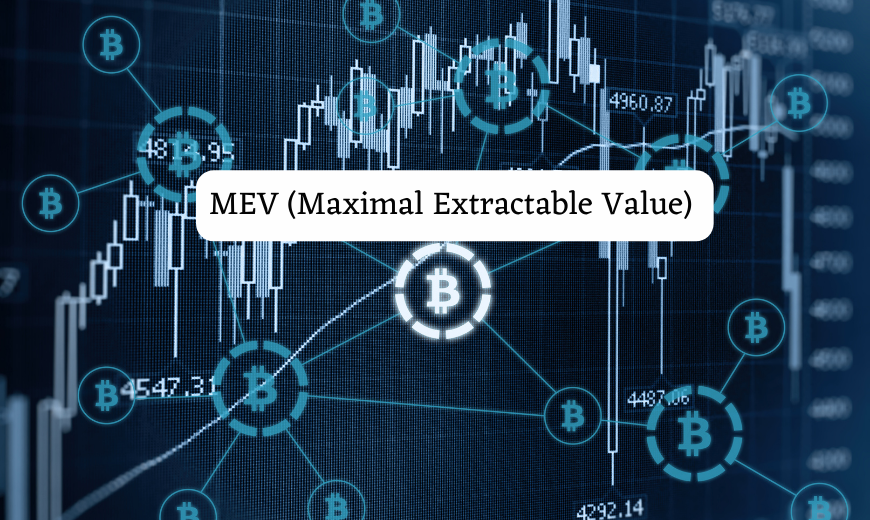
As we always say, ‘Cryptocurrency is an ever-evolving and dynamic sector where, every day, new innovations are made.’ And in recent times, a concept with the name of Maximal extractable value (MEV) has also gained significant popularity. In this comprehensive guide, we’ll shed light on the meaning of this concept. As a cryptocurrency enthusiast, many of you might even know a little about Maximal Extractable Value (MEV). But only a few of you would know exactly what MEV (Maximal Extractable Value) in crypto means.
So, without talking much. Let’s jump straight to this blog post.
What Does MEV (Maximal Extractable Value) Mean in Crypto?
MEV, aka Maximum Extractable Value, refers to the maximum potential profit that miners and other participants in decentralized finance (DeFi) networks can extract through front-running, arbitrage, and other transaction sequencing strategies.
Sounds a little technical?
Let’s understand this in simpler terms,
MEV (Maximal Extractable Value) is the maximum amount of money someone can make by strategically timing and ordering transactions on blockchain networks to their advantage. Understand this by reading this example.
An Example
Imagine you want to buy 10 ETH (Ethereum) using DAI (a stablecoin) on a DEX. Eventually, you submit your transaction to the network, and it’s waiting to be confirmed by a miner.
(AN IMPORTANT INFO: As a crypto enthusiast, you might know that on a DEX, the price of ETH (or any cryptocurrency) is determined by supply and demand. If more people want to buy ETH, the price goes up. If the majority of people want to sell ETH, the price goes down.)
In this example, you are buying a large amount of ETH. It means you’re adding a high demand for ETH.
(AN IMPORTANT INFO: When you place a ‘Large Buy Order,’ a signal will be passed to DEX that there is a higher demand for ETH. To match your buy order, the DEX may have to fulfill it with several smaller sell orders from different sellers, possibly at progressively higher prices. In the crypto world, this process is called ‘Slippage.’ The bottom line is That the Average price you pay for ETH might be higher than the current market price because your larger order has to be matched with multiple smaller sell orders at varying prices.)
As you may know, Miners (other network participants) can see pending transactions in the transaction pool (also called the mempool).
After witnessing your ‘Large Buy Order,’ they may realize that once your transaction is processed, the demand for ETH on the DEX will increase.
By getting informed of this, they use this information to make a profit. Also, they may place their own buy and sell orders around yours to make a profit, which is what MEV (Maximal Extractable Value) is all about. Miners use different methods to do this (which will be discussed later in this blog).
When was the First MEV Activity Made?
The first MEV (Maximal Extractable Value) activity was traced in 2014 by Pmcgoohan, an algorithmic trader. At that time, these kinds of suspicious activities were not categorized. In 2019, smart contractor researcher Phil Daian talked about these activities in a research paper titled “Flash Boys 2.0”. Moreover, it was Daian who coined the term ‘Miner Extractable Value’ or MEV. Later, it famously started being referred to as ‘Maximal Extractable Value.’
What Tactics Are Being Used by Miners to Extract MEV?
Miners use various types of tactics to extract MEV and gain profits. Some of the common tactics are mentioned below:
1. Front-Running
Front-running involves placing a transaction in a block before other transactions that are expected to affect the price of an asset. Miners can prioritize their transactions over others by paying higher gas fees.
Example: If a miner sees a large buy order for a cryptocurrency, they can place their own buy order first, causing the price to rise. At last, they can sell their coins at a higher price immediately after executing the large buy order.
2. Back-running
Back-running occurs when a miner places a transaction immediately after a large transaction that is expected to move the market. Therefore, this allows the miner to take advantage of the price movement caused by the first transaction.
Example: After noticing a large sell order, a miner places their own sell order right after. The large sell order lowers the price, and the miner benefits from selling before the market can adjust.
3. Sandwich Attacks
Sandwich attacks involve placing two transactions around a target transaction. Miners buy before the target transaction to benefit from the price increase and then sell after the target transaction to capture the profit.
Example: A miner detects a large buy order for a token. They first place a buy order to increase the price and then place a sell order right after the large buy order, profiting from the price increase caused by the target transaction.
4. Transaction Reordering
Transaction reordering allows miners to rearrange the order of transactions within a block to maximize their profits. This tactic can be used to front-run or back-run other transactions.
Example: A miner identifies several transactions involving the same token. By reordering them, the miner ensures that their transactions are executed at optimal times to benefit from price changes.
5. Priority Gas Auctions (PGAs)
In PGAs, miners participate in gas fee auctions to get their transactions included in the next block. By bidding higher gas fees, they can ensure their transactions are prioritized over others.
Example: A miner wants to execute a profitable arbitrage trade. Hence, they participate in a gas auction, offering higher fees to ensure their transaction is included in the next block ahead of others, securing the arbitrage opportunity.
6. Flash Loans
Flash loans are uncollateralized loans that must be repaid within a single transaction. Eventually, miners use flash loans to execute complex arbitrage opportunities without risking their own capital.
Example: A miner borrows a large sum through a flash loan, uses it to buy an asset at a low price, sells it at a higher price on a different exchange, and repays the loan all within the same transaction, pocketing the profit.
Strategies to Mitigate MEV (Minimal Extractable Value) Exploitation in Crypto
As of April 2023, MEV Bots have extracted over $1.38 billion from Ethereum users so far. The final data for 2024 can be expected to arrive later this year. But the numbers will surely be quite high this year. Thus, it is essential to educate our audience to mitigate MEV exploitation. Below are some strategies that you can adopt.
1. Fair Transaction Ordering
Fair transaction ordering, such as First-In-First-Out (FIFO), ensures that transactions are processed in the order they are received. Eventually, this prevents miners from reordering transactions to prioritize their own and gain unfair advantages, reducing front-running and other MEV exploits.
2. Batch Auctions
Batch auctions process transactions in bulk at regular intervals rather than individually. This approach limits miners’ ability to manipulate the sequence of transactions for profit. By aggregating transactions, it becomes more difficult to identify and exploit specific trades, thus mitigating MEV.
3. Decentralized Matchmaking
Decentralized matchmaking services match buy and sell orders without revealing transaction details to miners. This can prevent miners from seeing and exploiting these transactions before they are executed, reducing opportunities for front-running and other forms of MEV.
4. Commit-Reveal Schemes
In commit-reveal schemes, users first commit to a transaction by publishing a hash of the transaction details. After a set period, they reveal the actual information. This two-step process obscures the transaction details from miners until it is too late to exploit them, thereby mitigating MEV.
5. Privacy Enhancements
Technologies like zk-SNARKs and confidential transactions help to keep transaction details private. By hiding critical information, these technologies make it difficult for miners to identify profitable MEV opportunities, thereby reducing the risk of exploitation.
6. EIP-1559
Ethereum Improvement Proposal (EIP) 1559 introduces a base fee mechanism for transactions, which aims to make gas fees more predictable and stable. Eventually, this reduces the incentive for front-running, as the variability and predictability of transaction costs are lowered.
7. Flashbots
Flashbots is an organization focused on mitigating MEV by creating transparent and efficient MEV markets. Moreover, their system allows users to submit transactions directly to miners through a private communication channel, protecting them from public mempool exploitation and reducing MEV opportunities.
Wrapping Up
Maximal Extractable Value (MEV) in crypto refers to the additional profits that miners or validators can extract from transaction ordering within a block. Miners use various tactics, such as front-running, back-running, and sandwich attacks, to exploit the timing and sequencing of transactions for financial gain.
With the rising popularity of Maximal Extractable Value, one question is also gaining a lot of attention – Are MEV Bots Good or Bad?
Honestly, MEV bots present a double-edged sword in the crypto ecosystem. On the one hand, they can contribute to market efficiency by arbitraging price differences and enhancing liquidity. On the other hand, their activities can undermine the fairness and integrity of blockchain transactions, leading to increased costs and negative experiences for regular users. But still, whatever benefits they may offer, playing with crypto transactions is absolutely wrong.
With this, we would like to wrap up this blog post.
Thanks for reading this!
If you’re confused about any blockchain-related query, you know where to come – ‘The Blockchainist.’






